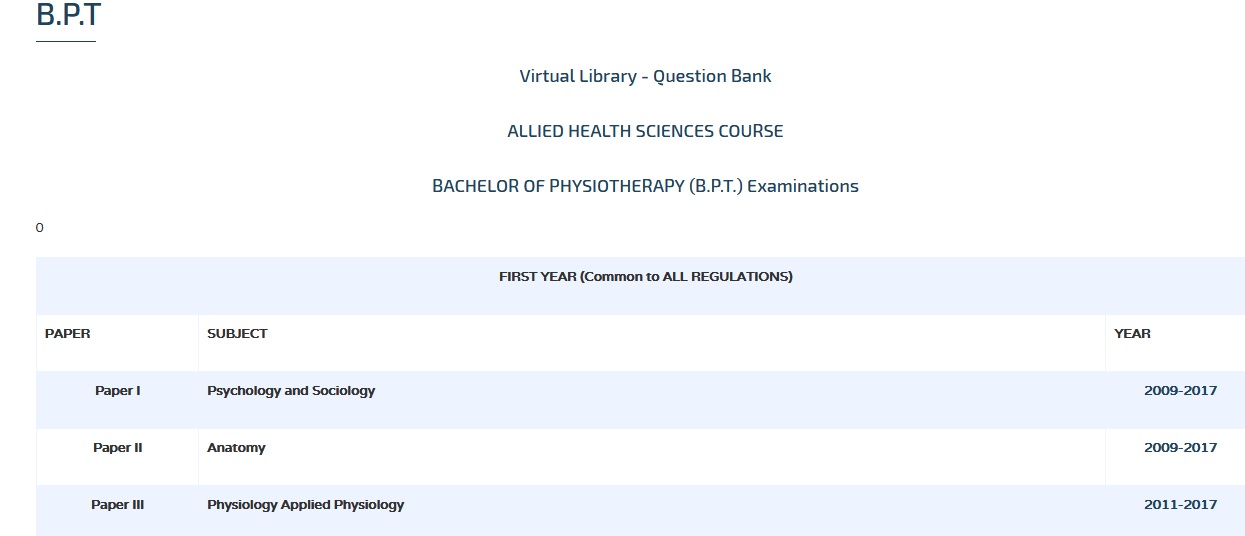Physiology & Applied Physiology BPT Question Bank : web.tnmgrmu.ac.in
Name of the University : The Tamilnadu Dr. M.G.R. Medical University
Degree : BACHELOR OF PHYSIOTHERAPY B.P.T.
Subject Code/Name : 6253/Physiology And Applied Physiology
Year : I
Paper : III
Document Type : Question Bank
Website : web.tnmgrmu.ac.in
Download Model/Sample Question Paper :
2009-2014 : https://www.pdfquestion.in/uploads/web.tnmgrmu.ac.in/PHYSIOTHERAPY/3707-746253KU.pdf
TNMGRMU Applied Physiology Question Bank
Time : Three hours
Maximum : 100 marks
Related / Similar Question Bank :
TNMGRMU BOT Physiology & Psychiatry Question Bank
August 2011
Sub. Code : 6253
BACHELOR OF PHYSIOTHERAPY EXAMINATION :
Paper III : PHYSIOLOGY AND APPLIED PHYSIOLOGY
Q.P. Code : 746253

ANSWER ALL QUESTIONS :
I. LONG ESSAYS (2X20=40)
1. Describe the transport of carbon-di-oxide in the blood.
2. Name the various endocrine glands in the body and describe growth hormone and applied physiology.
II. SHORT NOTES (8X5=40)
1. Endoplasmic Reticulum.
2. Functions of liver.
3. Neuromuscular junction.
4. Functions of pancreas.
5. Hormones of Adrenal Gland.
6. Functions of Leucocytes.
7. Heart sounds.
8. Neuralgia.??
III. SHORT ANSWERS (10X2=20)
1. Define Homeostasis.
2. Define Erythrocyte sedimentation rate.
3. Define Glomerular Filtration Rate.
4. Types of muscles.
5. Define Ovulation.
6. Types of bone cells.
7. Define tidal volume.
8. Glands of the skin.
9. Composition of the blood.
10. Properties of Platelets.
August 2011
I. Elaborate on: (2X20=40)
1. Discuss the mechanism of Skeletal Muscle Contraction.
2. Define Erythroporiesis. Discuss the factors influencing erythropoiesis.
II. Write notes on: (8X5=40)
1. Functions of Thyroxine.
2. Electrocardiogram.
3. Oxygen Dissociation Curve.
4. Cerebrospinal Fluid.
5. Visual Pathway.
6. Micturition Reflex.
7. Lung Volume and Capacities.
8. Properties of Synapse.
III. Short Answers: (10X2=20)
1. List any four functions of Cerebellum.
2. Cyanosis.
3. Slow and fast Muscle Fibre.
4. Reflex Arc.
5. Functions of Bile.
6. Heart Sounds.
7. Name the Cardio –Vascular Reflexes.
8. Erythroblastosis Foetalis.
9. Taste Pathway.
10. Functions of Testosterone.

February 2012
(180 Min)
Answer ALL questions in the same order. :
I. Elaborate on: Pages Time Marks
1. Define Neuro- Muscular Junction. Describe the transmission of impulses across Neuro-Muscular Junction.
2. Discuss the mechanism of Blood Clotting.
II. Write notes on:
1. Electrocardiogram.
2. Muscle Spindle.
3. Bile.
4. Oxygen Dissociation Curve.
5. Functions of Thyroxine.
6. Micturition.
7. Motor Unit.
8. Menstrual Cycle.
III. Short Answers:
1. Functions of Cerebro Spinal fluid.
2. Tetanus and Clonus.
3. Erythroblastosis Foetalis.
4. List the functions of Kidney.
5. Hypoxia.
6. Functions of Placenta.
7. Saltatory Conduction.
8. Heart Sounds.
9. List Four functions of Cortisol.
10.All or none Law.
February 2013
I. Elaborate on: (2X20=40)
1. Define arterial blood pressure and describe any five factors that determine blood pressure. Explain the Renin Angiotensin mechanism in regulation of blood pressure.
2. What is the normal fasting blood glucose level? Describe the hormonal regulation blood. Glucose level in the body. Add a note on diabetes mellitus.
(8X5=40)
II. Write notes on:
1. Properties of skeletal muscle.
2. Pain pathway.
3. Anticoagulants.
4. Contraception.
5.Deglutition.
6. Glomerular filtration rate.
7. Artificial respiration.
8. Pecularities of coronary circulation.
III. Short answers: (10X2=20)
1. What is gravindex test?
2. Draw a neat diagram of a Nephron and label its parts.
3. What is haemophilia ? and what is the cause for it ?
4. What are heart sounds and what are they due to?
5. List any four functions of gastric juice.
6. What is the role of basal ganglia in voluntary movement?
7. What are the hormones involved in regulation of water balance in the body?
8. Define stroke volume and what is the normal value?
9. What is timed vital capacity and its significance?
10. What is Wallerian degeneration?
August 2013
First Year BPT Exam
Paper III – Physiology And Applied Physiology
Q.P. Code : 746253
Time : Three Hours
I. Elaborate on : (2 x 20 = 40 )
1. Define cardiac cycle. Describe in detail the changes that occur in different phases of cardiac cycle with a suitable diagram.
2. Name the ascending tracts of spinal cord. Explain in detail the pain pathway and types of pain.
II. Write notes on : (8 x 5 = 40 )
1. Glomerular filtration rate
2. Functions of liver
3. Placental hormones
4. Chemical regulation of respiration
5. Parturition
6. Upper motor neuron(UMN) and Lower motor neuron lesion(LMN)
7. Carbohydrate metabolism
8. Spermatogenesis
III. Short Answers : (10 x 2= 20 )
1. Uses of Electrocardiogram
2. Salivary glands
3. Draw structure of cell
4. Cretinism
5. Define cardiac output
6. Acid base balance
7. Types of jaundice
8. What is anemia
9. Taste receptors
10. Regulation of pancreatic juice
I want answer key for all question papers
I want to previous exam pepars of anatomy and physiology of jabalpur University.. please help me
I want physiology, anatomy, biochemistry, previous year question papers of Dr.NTR University.
Please help me.
I want previous question papers of Dr.NTR University for BPT Physiology.
Please upload the question bank for BPF.
I want BPT 1st year Electrotherapy question paper.
I want important and repeatedly asking questions in Anatomy and Physiology.
I want question bank for Anatomy.
I need BPT 1st year question bank & answer key.
Please give me the answer sheet module for BPT 1st year Physiology.
I want syllabus of first year MMBS. Please help me.
I want physiology question papers for year 2014,15 & 16.
I want more physiology university question papers.
I need Fundamentals of exercise therapy.